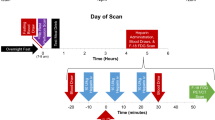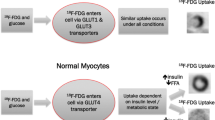Abstract
Purpose
We evaluated whether serum beta-hydroxybutyrate (BHB) can identify adequate suppression of the left ventricle (LV) among patients undergoing [18F]-fluorodeoxyglucose positron emission tomography ([18F]-FDG PET) for cardiac inflammatory/infectious studies.
Methods
Consecutive patients who underwent [18F]-FDG PET imaging were included. Serum BHB levels were measured in all patients on the day of imaging prior to injecting [18F]-FDG. Myocardial [18F]-FDG suppression was defined if [18F]-FDG uptake in the walls of myocardium, measured using standardized uptake values (SUV), was lower than the blood pool. The optimal threshold of BHB to identify myocardial suppression was based on receiver operating characteristics (ROC) in a random 30% sample of the study population (derivation cohort) and tested in the remaining 70% of sample (validation cohort).
Results
A total of 256 images from 220 patients were included. Patients with sufficient LV suppression had significantly higher BHB levels compared to those with non-suppressed myocardium (median (IQR) BHB 0.6 (0.3–0.8) vs. 0.2 (0.2–0.3) mmol/l, p < 0.001, respectively). BHB level ≥ 0.335 mmol/l had a sensitivity of 84.90% and a specificity of 92.60% to identify adequate LV suppression in the validation cohort. All patients (100%) with BHB ≥ 0.41 mmol/l had adequate myocardial suppression compared to 29.63% of patients with BHB ≤ 0.20 mmol/l.
Conclusion
Serum BHB level can be used at the point of care to identify sufficient LV suppression in patients undergoing [18F]-FDG PET cardiac inflammatory/infectious studies.
Graphical abstract
Central illustration (image to the right) shows representative cases of patient images and BHB and, in the image to the left, shows the sensitivity and specificity to identify left myocardial suppression using BHB in validation group.




Similar content being viewed by others

Data availability
The datasets generated during and/or analyzed during the current study are available from the corresponding author on reasonable request.
Abbreviations
- AUC:
-
Area under the curve
- BHB:
-
Beta-hydroxybutyrate
- EDV:
-
End-diastolic volume
- EF:
-
Ejection fraction
- ESV:
-
End-systolic volume
- FDG:
-
Fluorodeoxyglucose
- PET:
-
Positron emission tomography
- ROC:
-
Receiver operating characteristics
- SUV:
-
Standardized uptake value
References
Lawal I, Sathekge M. F-18 FDG PET/CT imaging of cardiac and vascular inflammation and infection. Br Med Bull. 2016;120:55–74. https://doi.org/10.1093/bmb/ldw035.
Kominsky DJ, Campbell EL, Colgan SP. Metabolic shifts in immunity and inflammation. J Immunol. 2010;184:4062–8. https://doi.org/10.4049/jimmunol.0903002.
Lopaschuk GD, Belke DD, Gamble J, Itoi T, Schönekess BO. Regulation of fatty acid oxidation in the mammalian heart in health and disease. Biochim Biophys Acta. 1994;1213:263–76. https://doi.org/10.1016/0005-2760(94)00082-4.
Kobayashi Y, Kumita S, Fukushima Y, Ishihara K, Suda M, Sakurai M. Significant suppression of myocardial (18)F-fluorodeoxyglucose uptake using 24-h carbohydrate restriction and a low-carbohydrate, high-fat diet. J Cardiol. 2013;62:314–9. https://doi.org/10.1016/j.jjcc.2013.05.004.
Dilsizian V, Bacharach SL, Beanlands RS, Bergmann SR, Delbeke D, Dorbala S, et al. ASNC imaging guidelines/SNMMI procedure standard for positron emission tomography (PET) nuclear cardiology procedures. J Nucl Cardiol. 2016;23:1187–226.
Lu Y, Sweiss NJ. Role of 18F-FDG PET/CT in cardiac sarcoid detection and therapy monitoring: addition to the expert consensus. J Nucl Med. 2019;60:292–3.
Ozutemiz C, Koksel Y, Froelich JW, Rubin N, Bhargava M, Roukuz H, et al. Comparison of the effect of three different dietary modifications on myocardial suppression in (18)F-FDG PET/CT evaluation of patients for suspected cardiac sarcoidosis. J Nucl Med. 2021;62:1759–67. https://doi.org/10.2967/jnumed.121.261981.
Newman JC, Verdin E. β-Hydroxybutyrate: a signaling metabolite. Annu Rev Nutr. 2017;37:51–76. https://doi.org/10.1146/annurev-nutr-071816-064916.
Heidenreich PA, Bozkurt B, Aguilar D, Allen LA, Byun JJ, Colvin MM, et al. 2022 AHA/ACC/HFSA Guideline for the Management of Heart Failure: Executive Summary: a report of the American College of Cardiology/American Heart Association Joint Committee on Clinical Practice Guidelines. Circulation. 2022;145:e876–94. https://doi.org/10.1161/cir.0000000000001062.
Osborne MT, Hulten EA, Murthy VL, Skali H, Taqueti VR, Dorbala S, et al. Patient preparation for cardiac fluorine-18 fluorodeoxyglucose positron emission tomography imaging of inflammation. J Nucl Cardiol. 2017;24:86–99. https://doi.org/10.1007/s12350-016-0502-7.
Dilsizian V, Bacharach SL, Beanlands RS, Bergmann SR, Delbeke D, Dorbala S, et al. ASNC imaging guidelines/SNMMI procedure standard for positron emission tomography (PET) nuclear cardiology procedures. J Nucl Cardiol. 2016;23:1187–226. https://doi.org/10.1007/s12350-016-0522-3.
Youden WJ. Index for rating diagnostic tests. Cancer. 1950;3:32–5. https://doi.org/10.1002/1097-0142(1950)3:1%3c32::aid-cncr2820030106%3e3.0.co;2-3.
Lee PI, Cheng G, Alavi A. The role of serial FDG PET for assessing therapeutic response in patients with cardiac sarcoidosis. J Nucl Cardiol. 2017;24:19–28. https://doi.org/10.1007/s12350-016-0682-1.
Ahmed AI, Abebe AT, Han Y, Alnabelsi T, Agrawal T, Kassi M, et al. The prognostic role of cardiac positron emission tomography imaging in patients with sarcoidosis: a systematic review. J Nucl Cardiol. 2021;28:1545–52. https://doi.org/10.1007/s12350-021-02681-z.
Selvaraj S, Seidelmann SB, Soni M, Bhattaru A, Margulies KB, Shah SH, et al. Comprehensive nutrient consumption estimation and metabolic profiling during ketogenic diet and relationship with myocardial glucose uptake on FDG-PET. Eur Heart J Cardiovasc Imaging. 2022. https://doi.org/10.1093/ehjci/jeac031.
Chareonthaitawee P, Beanlands RS, Chen W, Dorbala S, Miller EJ, Murthy VL, et al. Joint SNMMI–ASNC expert consensus document on the role of 18F-FDG PET/CT in cardiac sarcoid detection and therapy monitoring. Springer. 2017;24:741–1758. https://doi.org/10.2967/jnumed.117.196287.
Liu B, Hutchison AT, Thompson CH, Lange K, Wittert GA, Heilbronn LK. Effects of intermittent fasting or calorie restriction on markers of lipid metabolism in human skeletal muscle. J Clin Endocrinol Metab. 2021;106:e1389–99. https://doi.org/10.1210/clinem/dgaa707.
Veech RL, Bradshaw PC, Clarke K, Curtis W, Pawlosky R, King MT. Ketone bodies mimic the life span extending properties of caloric restriction. IUBMB Life. 2017;69:305–14. https://doi.org/10.1002/iub.1627.
Selvaraj S, Margulies K, Dugyala S, Schubert E, Tierney A, Arany Z, et al. Comparison of exogenous ketone administration versus dietary carbohydrate restriction on myocardial glucose suppression: a crossover clinical trial. J Nucl Med. 2021. https://doi.org/10.2967/jnumed.121.262734.
Renguet E, Bultot L, Beauloye C, Horman S, Bertrand L. The regulation of insulin-stimulated cardiac glucose transport via protein acetylation. Front Cardiovasc Med. 2018;5:70. https://doi.org/10.3389/fcvm.2018.00070.
Author information
Authors and Affiliations
Contributions
Mouaz Al-mallah contributed to the study conception and design. Material preparation, data collection, and analysis were performed by Moath Said Alfawara, Ahmed Ibrahim Ahmed, Jean Michel Saad, Yushui Han, Fares Alahdab, and Mahmoud Al Rifai. The first draft of the manuscript was written by Moath Said Alfawara, and all authors commented on previous versions of the manuscript. All authors read and approved the final manuscript.
Corresponding author
Ethics declarations
Conflict of interest
Dr. Al-Mallah receives support from the Houston Methodist Research Institute and Siemens. No other potential conflicts of interest relevant to this article exist.
Additional information
Publisher's note
Springer Nature remains neutral with regard to jurisdictional claims in published maps and institutional affiliations.
This article is part of the Topical Collection on Cardiology.
Supplementary Information
Below is the link to the electronic supplementary material.
Rights and permissions
Springer Nature or its licensor (e.g. a society or other partner) holds exclusive rights to this article under a publishing agreement with the author(s) or other rightsholder(s); author self-archiving of the accepted manuscript version of this article is solely governed by the terms of such publishing agreement and applicable law.
About this article
Cite this article
Alfawara, M.S., Ahmed, A.I., Saad, J.M. et al. The utility of beta-hydroxybutyrate in detecting myocardial glucose uptake suppression in patients undergoing inflammatory [18F]-FDG PET studies. Eur J Nucl Med Mol Imaging 50, 1103–1110 (2023). https://doi.org/10.1007/s00259-022-06062-7
Received:
Accepted:
Published:
Issue Date:
DOI: https://doi.org/10.1007/s00259-022-06062-7



